

The Cell (biology) The cell (from Latin cella, meaning "small room"[1]) is the basic structural, functional and biological unit of all known living organisms.
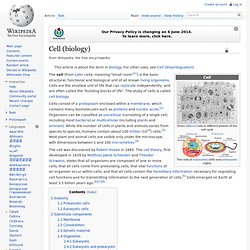
Cells are the smallest unit of life that can replicate independently, and are often called the "building blocks of life". The study of cells is called cell biology. The cell was discovered by Robert Hooke in 1665. The cell theory, first developed in 1839 by Matthias Jakob Schleiden and Theodor Schwann, states that all organisms are composed of one or more cells, that all cells come from preexisting cells, that vital functions of an organism occur within cells, and that all cells contain the hereditary information necessary for regulating cell functions and for transmitting information to the next generation of cells.[5] Cells emerged on Earth at least 3.5 billion years ago.[6][7][8] Anatomy There are two types of cells, eukaryotes, which contain a nucleus, and prokaryotes, which do not. Eukaryote. Eukaryotes can reproduce both asexually through mitosis and sexually through meiosis and gamete fusion.
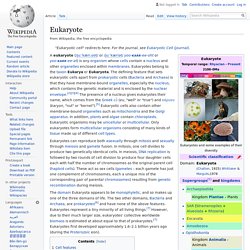
In mitosis, one cell divides to produce two genetically identical cells. In meiosis, DNA replication is followed by two rounds of cell division to produce four daughter cells each with half the number of chromosomes as the original parent cell (haploid cells). These act as sex cells (gametes – each gamete has just one complement of chromosomes, each a unique mix of the corresponding pair of parental chromosomes) resulting from genetic recombination during meiosis.
Cell features[edit] Eukaryotic cells are typically much larger than those of prokaryotes. Internal membrane[edit] Detail of the endomembrane system and its components A 3D rendering of an animal cell cut in half. The nucleus is surrounded by a double membrane (commonly referred to as a nuclear membrane or nuclear envelope), with pores that allow material to move in and out. Vesicles may be specialized for various purposes. Organelle. Mitochondrion. Two mitochondria from mammalian lung tissue displaying their matrix and membranes as shown by electron microscopy History[edit] The first observations of intracellular structures that probably represent mitochondria were published in the 1840s.[13] Richard Altmann, in 1894, established them as cell organelles and called them "bioblasts".[13] The term "mitochondria" itself was coined by Carl Benda in 1898.[13] Leonor Michaelis discovered that Janus green can be used as a supravital stain for mitochondria in 1900.
Friedrich Meves, in 1904, made the first recorded observation of mitochondria in plants (Nymphaea alba)[13][14] and in 1908, along with Claudius Regaud, suggested that they contain proteins and lipids. Benjamin F. Kingsbury, in 1912, first related them with cell respiration, but almost exclusively based on morphological observations.[13] In 1913 particles from extracts of guinea-pig liver were linked to respiration by Otto Heinrich Warburg, which he called "grana". Cell nucleus. HeLa cells stained for the cell nucleus DNA with the BlueHoechst dye.
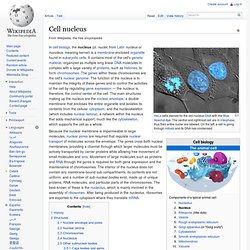
The central and rightmost cell are in interphase, thus their entire nuclei are labeled. On the left, a cell is going through mitosis and its DNA has condensed. Because the nuclear membrane is impermeable to large molecules, nuclear pores are required that regulate nuclear transport of molecules across the envelope. The pores cross both nuclear membranes, providing a channel through which larger molecules must be actively transported by carrier proteins while allowing free movement of small molecules and ions. Evolution of cells. The first cells[edit]
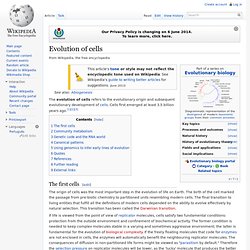
Prokaryote. Cell structure of a bacterium , one of the two domains of prokaryotic life. The division to prokaryotes and eukaryotes reflects two distinct levels of cellular organization rather than biological classification of species. Prokaryotes include two major classification domains: the bacteria and the archaea . Archaea were recognized as a domain of life in 1990. These organisms were originally thought to live only in inhospitable conditions such as extremes of temperature , pH , and radiation but have since been found in all types of habitats . [ edit ] Relationship to eukaryotes The division to prokaryotes and eukaryotes is usually considered the most important distinction among organisms.
Archaea. The Archaea ( Archaea were initially classified as bacteria, receiving the name archaebacteria (or Kingdom Monera), but this classification is outdated.[1] Archaeal cells have unique properties separating them from the other two domains of life: Bacteria and Eukaryota.
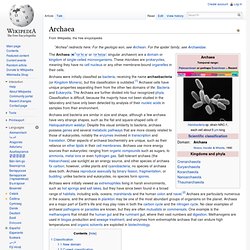
The Archaea are further divided into four recognized phyla. Classification is difficult, because the majority have not been studied in the laboratory and have only been detected by analysis of their nucleic acids in samples from their environment. Classification[edit] New domain[edit] Bacteria. Bacteria ( Most bacteria have not been characterised, and only about half of the bacterial phyla have species that can be grown in the laboratory.[10] The study of bacteria is known as bacteriology, a branch of microbiology.

Etymology Origin and early evolution Morphology Many bacterial species exist simply as single cells, others associate in characteristic patterns: Neisseria form diploids (pairs), Streptococcus form chains, and Staphylococcus group together in "bunch of grapes" clusters. Even more complex morphological changes are sometimes possible. Cellular structure Structure and contents of a typical gram-positive bacterial cell (seen by the fact that only one cell membrane is present). Intracellular structures The bacterial cell is surrounded by a cell membrane (also known as a lipid, cytoplasmic or plasma membrane). Many important biochemical reactions, such as energy generation, use concentration gradients across membranes. Extracellular structures Endospores.